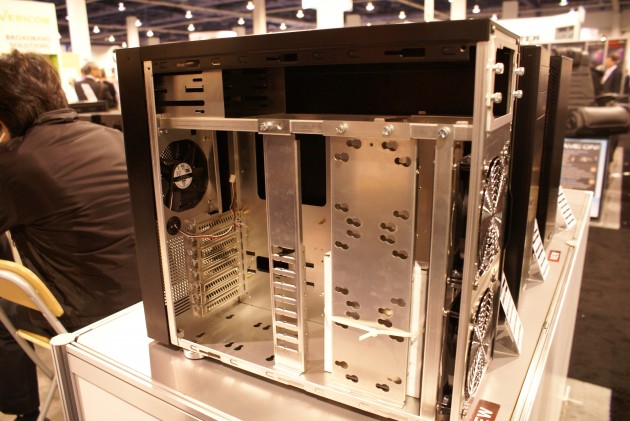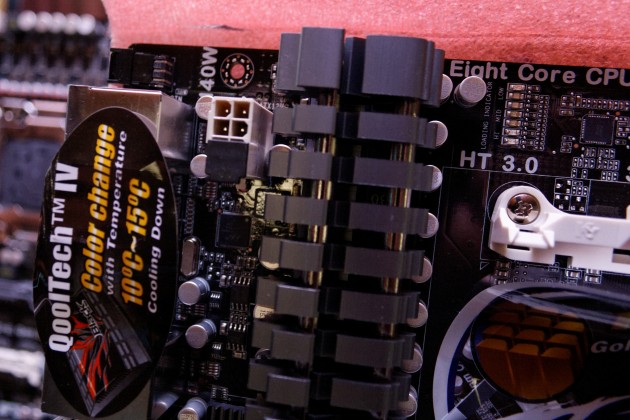Icrontic took some time to meet up with Lian Li on the CES 2012 showfloor to check out their chassis lineup. We were shown a massive lineup of PC cases across all major form factors. From extremely small HTPC chassis to massive full size server boxes, Lian Li boasts an impressive array of sleek and simple computer case solutions. Keeping in line with their famously low-key design language, almost every one of their chassis featured efficient simplicity. Copious bright lights, massive windows, and ridiculous paint jobs were nowhere to be seen, replaced instead with dark aluminum, conservative shapes, and astoundingly functional interiors. Signature Lian Li style.
Among these cases, one new design was particularly compelling. It didn’t catch our eyes with a bold look on the exterior, but rather because of the decisions made on the interior. The new Lian Li PC-100 chassis features a front-facing I/O bracket position—the motherboard mounting tray is inverted to face toward the front of the case, rather than the rear. This means all of your USB, video out, audio jacks, and power ports are all at the front of the case. The ports are concealed behind a simple swinging door, keeping the front of the chassis clean and attractive once everything is plugged into the motherboard.
 This sort of design is an interesting move for Lian Li. We don’t see case manufacturers muck about with the motherboard mounting position very often—the Silverstone RAVEN is one of the few examples (which puts the I/O bracket at the top). But just because companies haven’t made previous attempts to make such an enormous adjustment doesn’t mean we don’t need it. Such a design introduces many new benefits, as well as drawbacks.
This sort of design is an interesting move for Lian Li. We don’t see case manufacturers muck about with the motherboard mounting position very often—the Silverstone RAVEN is one of the few examples (which puts the I/O bracket at the top). But just because companies haven’t made previous attempts to make such an enormous adjustment doesn’t mean we don’t need it. Such a design introduces many new benefits, as well as drawbacks.
The obvious advantage to such a setup is easier access to all of your computer’s ports. No longer will you need to fumble around in the darkness behind your machine as you try to plug a USB device in. Everything is clearly visible at the front. The PC-100 has a built in cable trench along the side, enabling you to cleanly clip in the cables from the PC’s ports, keeping the front from becoming a mess of random cables.
The design could introduce a few new issues. Cooling could be affected, as most video cards will end up exhausting hot air out to the front, which depending on the rest of the fan setup on the chassis, could potentially pull the hot air back inside. Additionally, if you wish to wire your cables up the back of your desk to your peripherals, you may need to acquire longer cables to compensate for the fact that they must be plugged into the front. Despite these potential issues, this design could not only be great for PC builders, but it could be the kind of move that revolutionizes PC hardware. If you ask me, we need more companies that are willing to take design risks like that.
Shaking up the PC design paradigm
PC hardware is an industry with very little change. In the last 15 years, we have seen very few shakeups that changed the way computers are built and how they function. With cases specifically, things have been relatively unchanged ever since building PCs became a geek pastime. It wasn’t until recently that case design saw one of its biggest revolutions when placing power supplies at the bottom rather than the top became a regular occurrence. This change made sense for many reasons, especially when you consider weight distribution, and was a welcome adjustment that we never knew we wanted. The lack of innovation in chassis design over the years leading up to this change wasn’t an indication that we didn’t need new designs, we just needed someone to step forward and start asking the right questions.
Icrontic also had a quick meeting with ECS admist the chaos of CES. While we were shown some of their new motherboard designs up in their private suite, we were particularly impressed by what would typically be seen as an unimportant detail. The 8-pin CPU power connector was elevated a full inch and a half above the surface of the motherboard. This allows the builder to plug the CPU power in without struggling to get their fingers into the small space dominated by the large passive cooling fins (it also prevents the painful cuts those fins generally dish out). This is a simple design change that left us dumbfounded—why in the world hadn’t anyone else ever considered doing something like this before?
We don’t need hardware manufacturers to reinvent the wheel, but new designs and ideas are certainly welcome. The industry has been design stagnant for years, and PC builders want innovation to shake things up. Fortunately, we have companies like Lian Li and ECS trying new things that will, with a little luck and enthusiastic consumers, change our industry for the better.
The bold decision to mount the motherboard inversely on the Lian Li PC-100 may not be useful to every system builder out there, and we probably won’t see this mounting style become commonplace. But as such a design is indeed useful, it will resonate with users that have specific needs met by a backward-facing motherboard. Hopefully, it’s situations like this that will allow the new style found on the PC-100 to give consumers plenty of new, different options when shopping for a PC chassis. A market of variety will mean happier consumers and more interesting builds. Here’s to hoping that more designers decide to push unique new ideas in the future to continue to improve our wonderful hobby.












 Articles RSS
Articles RSS